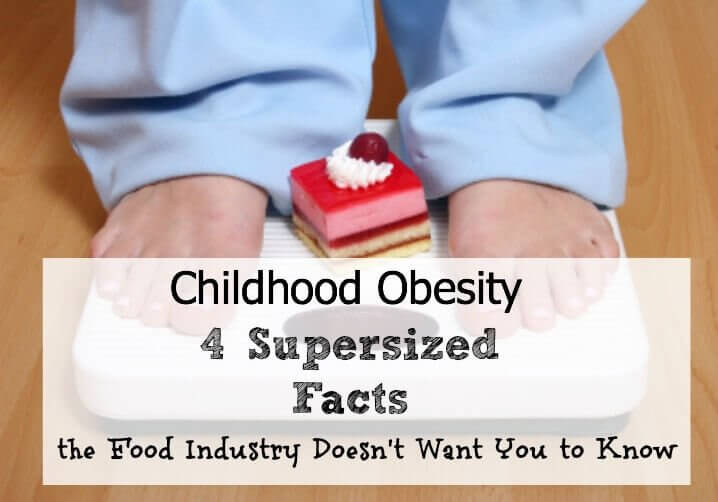Childhood Obesity: 4 Supersized Facts the Food Industry Doesn’t Want You to Know

By Andrea, Contributing Writer
When we were given the task of tackling tough topics, I immediately thought of childhood obesity.
The facts on childhood obesity cannot be disputed. One third of American children are currently obese according to the CDC.
This is a monumental crisis when you consider that obesity leads to high blood pressure, high cholesterol, cardiovascular disease, insulin resistance, type 2 diabetes, breathing problems, joint problems and fatty liver disease. (source)
Have you ever tried to lose weight? You know it is hard. It breaks my heart for these kids.
So much is made of the parent’s role and personal responsibility. However, I don’t think that paints the full picture.
Our children are being led down this path to obesity by the food industry.
Consider these 4 Supersized Facts the Food Industry Doesn’t Want You To Know
1. The food industry spends $1.6 billion each year marketing to children.
An American child will see an average of 15 unhealthy food related ads each day. That statistic includes television, in-store and Internet ads.
That adds up to an average of 5,500 unhealthy food commercials viewed in a year!
These commercials are for products such as high-sugar breakfast cereals, fast food, soft drinks, candy and snacks. In contrast, an average child sees less than 100 marketing messages for healthy, whole foods in a year.
Research shows this constant exposure to unhealthy food-related ads undeniably tempts our children with unhealthy food choices. By marketing poor food choices to our children, the food industry is setting our children up for a lifetime of unhealthy eating habits.
2. Processed foods mean big profits.
The food industry doesn’t make its money from fresh fruits and vegetables. The greatest profits for the food industry come from highly processed foods, such as soda, fast food and snack foods.
Cheap government-subsidized crops, such as corn and soybeans, are processed into highly-profitable food products devoid of any real nutrition. Most of the foods that offer the highest profitability lacks fiber, micronutrients and phytochemicals.
Matthew 6:24 wisely says, “No one can serve two masters.”
The food industry can’t claim to have a stake in helping end childhood obesity but be driven by the profits of an unhealthy food system that entices our children to eat and buy more.
3. Kids don’t feel full from eating junk food.
The food industry definitely doesn’t want you to know that stripping foods of their nutritional value means it can’t satisfy even the smallest appetites.
Take the example of a Strawberry Fruit Gusher. A 1-ounce serving offers up 90 calories but no fiber. Research shows fiber is important to keep you full. So for your 90 calories, you aren’t full and need another snack.
The Strawberry Fruit Gushers also contain 13 grams of sugar.
In comparison, you need to eat 10 ounces of strawberries to equal a 90-calorie portion of strawberries. That portion, while not only larger, has 5 grams of fiber, abundant vitamins and minerals and dozens of phytochemicals. Because of the fiber and the larger serving size, the strawberries help fill a kid up with only 0.6 grams of sugar.
If you really think this through, the food industry has marketed something as a “snack” that won’t leave your child feeling full, so they will in turn need another snack.
In fact, the data shows that children are now eating three snacks per day, with 27% of their calories coming from snacks.
4. Many food industry health claims mean nothing.
By now you probably are well aware that to claim a product is “natural” does not meet anything when you read it on a product label.
Labeling food with misleading health claims is a major contributor to childhood obesity. It’s a bait-and-switch type operation–baiting us to purchase “healthy” foods that turn out to be detrimental to the health of our children.
Knowing the food industry’s tactics for enticing our kids with unhealthy choices helps us to avoid them. Making real food a priority is one step we can take to ending childhood obesity.






The food industry markets to children, children ask their parents for the thing the ads make so appealing, parents choose to buy these products for their children. Children don’t know these products are unhealthy and will make them fat but parents do. Or should know. Parents need to say no to unhealthy crap and yes to real food. If they are not doing this then they are the root of the childhood obesity epidemic.
Thank you for writing this post. I too try to minimize the amount of process food my children eat. It can be a challenge. Especially in my children’s school where, if there is to be a special snack, it has to be store-bought with allergens labeled on the package, instead of something made from scratch. Then there is the challenge of trying to teach your children why the stuff their friends eat isn’t really as good for you as real food, such as fruits and vegetables and other snack items made from scratch. And don’t get me started on how to deal with this when they come to the store with me. Although, for that situation, when they ask for something that isn’t nutritionally dense, I’ll ask them “How long do you (whatever the item may be) has been sitting on the shelf? Do you really want to put something that old in your body?” Ha, ha. That usually turns them off 🙂
There is an app on my iphone called Fooducate. When my kids ask for something in the grocery store, we scan the barcode into the phone and the app rates the item A-F. So they can see why I say no to most items and the info comes from the all powerful internet and not mom.
I think as parents, we need to be very diligent in reading the entire ingredient list of products we buy for our kids. It’s no good to rely on what the food manufacturer is telling us on the front of their packaging, because putting something like “contains real fruit” on the front of packaging isn’t giving the real and full story of what their “food” is all about. Great article!
My children avoid almost all of the junk food advertisements because we don’t own a TV. One more perk for us!
That’s a really good point you make about the highly processed snacks not making kids feel full. I recently bought a fruit rope thingy for a treat for my son and it advertised “one full serving of fruit!” The ingredients were really okay–apple juice, apple puree, no food dyes, and gelatin, I think–but I was thinking that if that was supposed to be his “snack” (instead of a treat like I intended it) there’s no way he’d feel satisfied after it! I’m thankful that he’s a good eater now as a two-year old so that it’s easy to get him used to eating healthy, filling things. I hope he’ll see those things as comfort foods when he’s older!
I watched a documentary on netflix today that tackles the issue of food insecurity in the US. 1 in 2 children in the US will go hungry at some point in their childhood.
The price of real food has gone up 40% (I believe it said over the last 20 years) while in comparison the price of processed food has gone down 40%.
With many families (some with 2 incomes) struggling to put food on the table, they turn to high calorie ‘junk’ to meet their needs.
One town (jonestown) has 3 grocery stores and save for some bananas, there are no fresh fruits or veggies. The truckers basically feel it’s not profitable to drive out of their way to service smaller towns.
The economy (and growing split between the haves and have nots) is causing people to rely on artificial filler foods to feed their children.
I was in tears because not only are 1 in 3 children obese (with a whole host of future health issues) many are suffering from developmental delays because of nutrient deficiencies.
It’s cruel, inhumane and unethical to say the least.
I think the most important fact is number three. The reason kids keep eating more and more is because they’re trying to get nutrients that just aren’t there!
Though, for the first fact, I have one question. What is the 1.6 billion in comparison to how much they spend on marketing to adults?
Reason #3 is so true! It’s like the difference between having two homemade cookies and two Oreos. I feel completely satisfied after eating homemade cookies, but I have had multiple friends admit to eating an entire package of Oreos without even realizing it. The junk food doesn’t satisfy, and just leaves you craving more. Which is probably why obesity is on the rise in adults too.
As far as childhood obesity specifically, I think another contributing factor is that kids aren’t as active as they used to be. When I was a kid we lived outside all summer, running around, swimming, riding bikes, and playing. Now, my kids are pretty much the only ones in the neighborhood who play outside with any regularity. I think a lot of kids would rather hang out inside and watch TV or play video games.